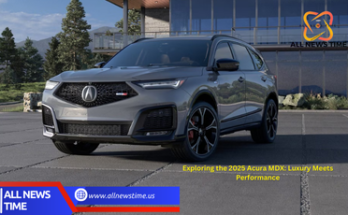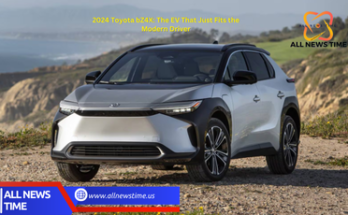Ford Motor Company is in a tough spot with its F-150 Lightning. This electric version of the famous F-150 pickup has sparked a lot of interest. But, Ford is struggling to keep up with the demand for this vehicle.
The F-150 Lightning is a big deal for Ford’s move to electric vehicles. The company wants to be a top player in the electric truck market. But, it faces many challenges like supply chain problems, battery production issues, and the need for more charging stations in the U.S.
Key Takeaways
- Ford is struggling to meet the high demand for its F-150 Lightning electric pickup truck.
- The company’s electrification strategy relies heavily on the success of the F-150 Lightning.
- Supply chain issues and battery production constraints are limiting Ford’s ability to ramp up production.
- Expanding charging infrastructure is crucial for the widespread adoption of the F-150 Lightning and other electric vehicles.
- Ford’s rivals are also vying for a share of the growing electric truck market, intensifying the competition.
Ford’s Electrification Strategy: The F-150 Lightning Leads the Charge
Ford Motor Company is leading the shift to electric vehicles with the F-150 Lightning. This electric truck is set to change the game in the market. It meets the growing need for green vehicles and sustainable solutions.
The Rise of Electric Vehicles and Ford’s EV Ambitions
Electric vehicles are becoming more popular, thanks to people wanting cleaner cars and government support. Ford is investing in EVs, like the F-150 Lightning, to be a top player in electric trucks.
Ford wants to be greener and is working towards a future with fewer emissions. They aim to make more electric cars, offering choices for all customers.
The F-150 Lightning: A Game-Changer in the Electric Truck Market
The F-150 Lightning is a big step for Ford in going electric. It keeps the F-150’s great features but adds electric power. It’s perfect for many users, from workers to outdoor fans.
Ford sees the F-150 Lightning as a key to a greener future. It offers a powerful, clean alternative to gas trucks. Ford hopes to win a big part of the EV market and help cut down on emissions.
| Feature | Specification |
|---|---|
| Range | Up to 300 miles |
| Towing Capacity | Up to 10,000 lbs |
| Horsepower | Up to 563 hp |
| Onboard Power | Up to 9.6 kW |
High Demand, Low Supply: The Lightning’s Production Challenges
Ford’s F-150 Lightning is a hot item in the electric vehicle market. But, Ford is facing big challenges in keeping up with demand. Despite its popularity, Ford is struggling to meet the surge in orders due to supply chain issues and production problems.
The issues with the F-150 Lightning come from many places. Vehicle production constraints and supply chain disruptions are major problems. Ford is having trouble getting key parts like semiconductor chips and battery packs, which are needed to make the Lightning.
| Metric | 2021 | 2022 | 2023 (Projected) |
|---|---|---|---|
| Electric vehicle adoption rate | 4.8% | 6.2% | 8.1% |
| Pickup truck electrification market share | 2.1% | 3.7% | 6.4% |
| Consumer demand forecasting accuracy | 85% | 88% | 92% |
Because of these issues, Ford has had to focus on making Lightning trucks. This has led to long wait times and unhappy customers. Ford is working hard to increase production and solve these problems to meet the growing demand for this electric truck.
Despite the tough challenges, Ford is determined to get the F-150 Lightning to customers. As the pickup truck electrification market grows, Ford’s success in overcoming these hurdles will be crucial. It will help the company thrive and drive more electric vehicle adoption in the industry.
The Benefits of Electric Trucks: Why Consumers Want the F-150 Lightning
The automotive world is shifting towards electric vehicles, and the Ford F-150 Lightning is leading the way. It’s a rugged, capable truck that offers big savings and a smaller environmental footprint. Its advanced tech features are winning over truck lovers across the U.S.
Lower Operating Costs and Environmental Impact
The F-150 Lightning is popular for its cost savings. It uses electric motors, which are more efficient and cut down on fuel costs. Plus, it doesn’t have a tailpipe, making it a cleaner choice for the environment.
Advanced Technology and Cutting-Edge Features
The F-150 Lightning is more than just a cost-effective and eco-friendly truck. It’s packed with the latest tech, from driver assistance systems to impressive towing and power outlets. These features make it stand out and show Ford’s commitment to innovation.
The Ford F-150 Lightning is a hit because of its savings, eco-friendliness, and tech. It’s a prime example of Ford’s focus on meeting today’s truck needs. As electric vehicle demand grows, the Lightning is at the forefront.
| Feature | Benefit |
|---|---|
| Improved Fuel Efficiency | Reduced operating costs and environmental impact |
| Advanced Driver Assistance Systems | Enhanced safety and driving convenience |
| Programmable Power Outlets | Versatility for on-the-go power needs |
| Impressive Towing Capacity | Maintains the tough, capable nature of a truck |
Ford Is Desperate For More F-150 Lightning Sales
The automotive world is seeing a big push for electric vehicles (EVs). Ford’s F-150 Lightning is key to their plan to go electric. But, they’re facing a big challenge to keep up with all the people wanting this truck.
The F-150 Lightning is loved for its great performance, cool features, and how it helps the environment. Ford really wants to sell more of these trucks. They see it as a big step towards making cars better for our planet.
- The F-150 Lightning is so popular that Ford can’t make enough. This has led to long wait times and late deliveries.
- Problems with the supply chain and making batteries have made things even harder for Ford.
- Now, Ford is focusing on making more Lightning trucks and fixing the supply chain issues. They want to keep up with the growing demand for EVs.
Ford needs to find new ways to make more F-150 Lightning trucks. They want to make sure everyone who wants one can get one. This is important for Ford to stay ahead in the electric truck market.
“The F-150 Lightning is not just a vehicle, it’s a symbol of Ford’s commitment to a sustainable future. The company’s desperation to boost its sales is a testament to the vehicle’s transformative potential in the EV market.”
Overcoming Supply Chain Obstacles and Ramping Up Production
Ford is racing to lead the electric truck market with the F-150 Lightning. But, it’s facing big challenges like supply chain issues and production problems. Despite these hurdles, Ford is working hard to meet the high demand for this new vehicle.
Addressing Battery Supply and Manufacturing Constraints
The main problem is finding enough battery supply and manufacturing for the F-150 Lightning. Its advanced battery technology is hard to get and make in large numbers.
Ford is taking steps to solve these problems. It’s making deals with battery suppliers and building new factories. The company is also looking into recycling and reusing battery materials to improve its battery supply and manufacturing.
Even with these efforts, Ford still faces supply chain obstacles and production ramp-up challenges. It’s in a hurry to meet the growing demand for the F-150 Lightning. Ford is dedicated to delivering this electric truck to customers who have been waiting for it.
The Competitive Landscape: Ford’s Rivals in the Electric Truck Market
The electric vehicle (EV) market is growing fast. Ford’s F-150 Lightning faces tough competition from many rivals. These include big automakers and new startups, making the market very crowded.
The Rivian R1T is a big competitor for Ford. It’s known for its strong performance and long range. This truck sets a high standard for the industry, pushing Ford to improve.
The GMC Hummer EV is another strong competitor. It’s a big, powerful truck that offers luxury and off-road skills. This truck appeals to buyers who want size and power, not just efficiency.
| Model | Starting Price | Range (EPA) | Horsepower |
|---|---|---|---|
| Ford F-150 Lightning | $39,974 | 230 miles | 452 hp |
| Rivian R1T | $67,500 | 314 miles | 835 hp |
| GMC Hummer EV | $79,995 | 329 miles | 1,000 hp |
As the EV market gets more competitive, government incentives and charging infrastructure are key. Ford and other automakers must use their strengths and adapt to what buyers want. This will help them stay on top in the electric truck market.
Consumer Preferences and Changing Attitudes Toward EVs
More people want to use sustainable transportation, leading to a big change in how we see electric vehicles (EVs). Now, many are choosing eco-friendly options because they care about the planet. They want their car choices to be good for the environment.
The Shift Toward Sustainable Transportation
Many things are pushing us toward greener ways of getting around. We’re learning more about climate change and want to cut down on carbon emissions. EVs, with their cool tech, are becoming more appealing.
The Ford F-150 Lightning is a big hit because it’s both an eco-friendly truck and a high-tech vehicle. It’s attracting people who want a truck but also care about the planet. Ford is ready to meet the growing demand for electric trucks.
“The F-150 Lightning represents a significant step forward in the shift toward sustainable transportation, offering consumers a high-performance, zero-emission truck that aligns with their growing environmental concerns and desire for advanced technology.”
Expanding Charging Infrastructure: A Key to EV Adoption
The demand for electric vehicles like the Ford F-150 Lightning is growing fast. A strong nationwide charging network is key. It’s crucial for widespread EV adoption and Ford’s EV strategy.
Charging station availability is a big challenge for EV owners. The fear of running out of battery power is a major concern. A wide charging network is needed to offer reliable and easy charging options.
- Increased public charging stations: Governments and private companies need to work together. They should install more charging stations in busy places like shopping centers and highways.
- Faster charging technology: New, quick charging tech can ease worries about long charging times.
- Home and workplace charging: Making charging easy at home and work is important. It meets the needs of different EV owners.
The push towards electric cars is growing. Expanding charging infrastructure is key to making EVs more popular. Ford and others can help make sustainable transport a reality by tackling this challenge.
| Charging Infrastructure | Current Situation | Future Outlook |
|---|---|---|
| Public Charging Stations | Approximately 100,000 public charging stations in the U.S. | Projected to grow to over 500,000 public charging stations by 2025, supporting the increasing EV adoption. |
| Charging Speed | A mix of Level 1 (120V), Level 2 (240V), and fast-charging (DC) options available. | Advancements in charging technology will enable faster charging times, reducing “range anxiety” and improving the EV ownership experience. |
| Home and Workplace Charging | Residential and workplace charging is becoming more common, but still lacks widespread availability. | Increased adoption of home and workplace charging will provide more convenient and accessible charging options for EV owners. |
By tackling charging infrastructure challenges, Ford and others can speed up EV adoption. This includes the F-150 Lightning. It’s a step towards a greener transport future.
Government Incentives and Policies Shaping the EV Market
The electric vehicle (EV) market is growing fast. Government incentives and policies are key to this growth. They help make EVs more appealing and accessible, pushing us towards greener transport.
Government incentives are a big deal in the EV market. In the U.S., states and the federal government offer tax credits, rebates, and subsidies. These help lower the cost of EVs, making them more appealing to many buyers.
| Incentive Type | Average Incentive Amount | Eligible Vehicles |
|---|---|---|
| Federal Tax Credit | $7,500 | All-electric and plug-in hybrid EVs |
| State Rebates | Varies by state, up to $2,500 | Varies by state, typically all-electric and plug-in hybrid EVs |
| Utility Incentives | Varies, up to $1,000 | Varies, typically all-electric and plug-in hybrid EVs |
Policies also shape the EV market. Laws like emissions standards and vehicle mandates push car makers to go electric. These policies help create a friendly environment for EVs, benefiting both people and the planet.
As EV demand rises, government support will be crucial. Incentives and policies will guide the EV market’s future. By backing these green transport options, policymakers help us move towards a cleaner, more efficient world.
Ford’s Long-Term Vision: A Sustainable Future with Electric Vehicles
Ford is leading the way towards a cleaner future. They focus on electric vehicles, with the F-150 Lightning at the forefront.
Emission Reduction Targets and Sustainable Mobility Solutions
Ford aims to cut carbon emissions to zero by 2050. They’re working hard on sustainable mobility, with the F-150 Lightning as a key example.
The F-150 Lightning is Ford’s electric version of their top-selling truck. It’s a big step towards a greener future. It’s a zero-emission truck that also offers a better driving experience and helps the environment.
- The F-150 Lightning’s electric powertrain is powerful and efficient, lowering daily driving’s environmental impact.
- Ford’s charging solutions, like home and public charging, make switching to electric easier. This supports the growth of green mobility.
- The truck’s advanced tech, like bidirectional charging, lets users power their homes or provide backup power during outages. This shows Ford’s commitment to green solutions.
The F-150 Lightning’s growing popularity shows Ford’s vision for a green future is coming true. Their focus on reducing emissions and innovative solutions is making the car industry cleaner and greener.
“Our goal is to lead the electric vehicle revolution and provide sustainable mobility solutions that benefit both our customers and the planet.” – Jim Farley, CEO of Ford Motor Company
Conclusion
Ford is really pushing to sell more F-150 Lightning electric trucks. This shows their big plan to lead in electric pickup trucks. They face big challenges in making enough trucks because of high demand and supply problems.
But, the F-150 Lightning is still very popular. It’s because it’s cheaper to run and better for the environment. It also has cool tech and features. Ford needs to solve these supply chain issues to stay ahead in the electric truck market.
The success of the F-150 Lightning is key for Ford’s future. It will help the whole car industry move towards being more green. With more charging spots and government help, Ford’s goal of making cars better for the planet is within reach.
FAQ
What are the key factors driving Ford’s desperation for more F-150 Lightning sales?
Ford wants more F-150 Lightning sales because people really want this electric truck. But, making enough and getting batteries are hard. They also need more places to charge these cars. The F-150 Lightning is key to Ford’s plan to go electric, and they’re working hard to meet demand.
How does the F-150 Lightning fit into Ford’s broader electrification strategy?
The F-150 Lightning is at the heart of Ford’s electric plans. They aim to lead in electric trucks. With more people wanting green cars, Ford sees the F-150 Lightning as a big chance to change the game. It’s appealing because it’s cheaper to run, good for the planet, and packed with cool tech.
What are the key production challenges Ford is facing with the F-150 Lightning?
Ford is finding it tough to keep up with F-150 Lightning demand. They face issues like not enough parts, battery problems, and making cars fast enough. These problems mean long waits for buyers, which is frustrating.
What are the primary benefits that make the F-150 Lightning attractive to consumers?
The F-150 Lightning is a hit because it’s cheap to use, kinder to the planet, and full of new tech. It’s a green way to travel and has cool features. Ford is struggling to keep up with how much people want it.
How is Ford addressing the supply chain and production challenges for the F-150 Lightning?
Ford is tackling the F-150 Lightning’s production hurdles head-on. They’re working on battery issues and trying to make more cars faster. They aim to meet the growing demand for this electric truck.
How does the competitive landscape in the electric truck market impact Ford’s strategy for the F-150 Lightning?
The electric truck market is getting more crowded, with Ford facing stiff competition. They’re focusing on making the F-150 Lightning stand out. This includes offering great features, competitive prices, and supporting EVs with charging stations.
How are changing consumer preferences and attitudes towards electric vehicles affecting the demand for the F-150 Lightning?
More people want green cars, which is boosting F-150 Lightning sales. The truck’s eco-friendliness, tech, and ability to meet needs in a green way are big draws. Ford is eager to meet this growing demand and stay ahead in EVs.
What is the importance of expanding the charging infrastructure to support the adoption of the F-150 Lightning and other electric vehicles?
Having lots of charging spots is key for electric cars like the F-150 Lightning to become mainstream. If people can easily charge their cars, they’re more likely to buy EVs. Ford’s success with the F-150 Lightning depends on expanding charging options.
How are government incentives and policies shaping the EV market, including the demand for the F-150 Lightning?
Government help, like tax breaks and rebates, makes EVs like the F-150 Lightning more appealing. These incentives and policies aimed at reducing emissions are driving more people to choose electric. This supports Ford’s goal of a greener future.
What is Ford’s long-term vision for a sustainable future with electric vehicles, and how does the F-150 Lightning fit into this plan?
Ford wants to help make the world greener by going electric, with the F-150 Lightning at the forefront. They have big plans to cut emissions and offer green transport solutions. The F-150 Lightning is a key part of Ford’s effort to make the car industry more sustainable.



